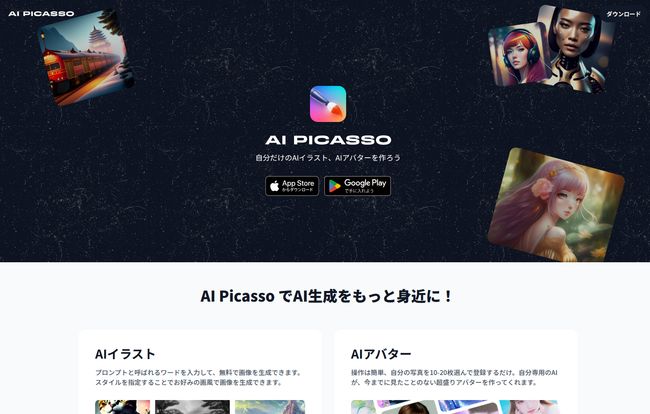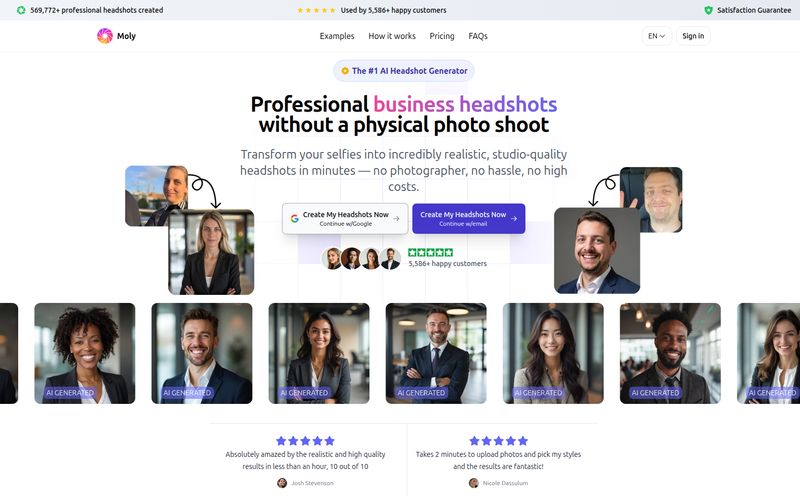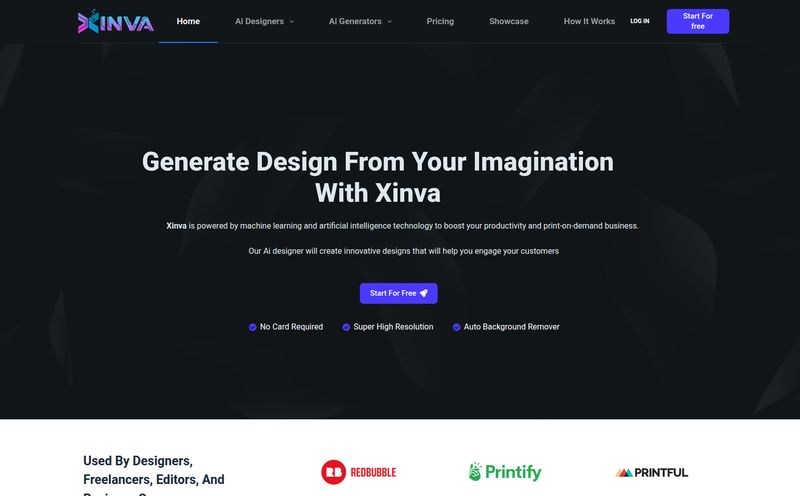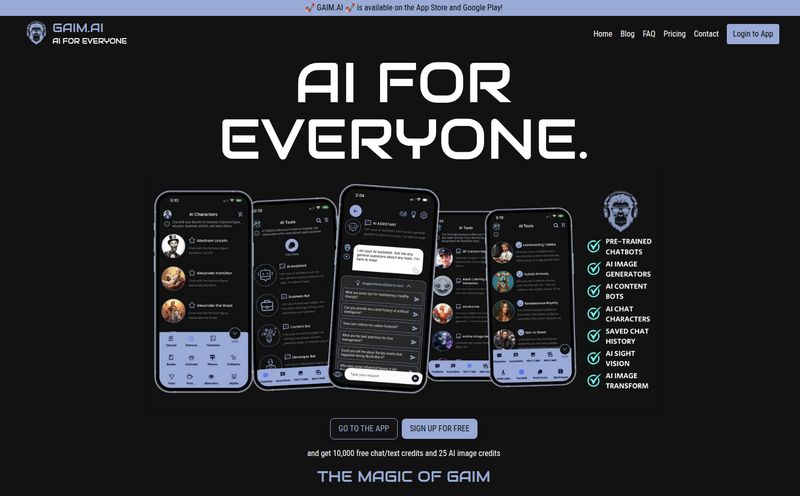In the world of SEO and digital content, you can't swing a cat without hitting a new AI tool. Every single week, it seems there's a new platform promising to revolutionize how we create images, write copy, or even generate video. It can be exhausting. So when I heard about AI Picasso, I'll admit I was a little skeptical. Another text-to-image generator? Groundbreaking.
But then I looked a little closer. Tucked away amongst the usual features was something a bit different, a bit more... personal. It wasn’t just trying to be the next Midjourney. It was leaning heavily into creating things from you. Your face, your pets, your style. And with a name like Picasso, well, you’re setting a certain expectation, aren't you? So, I decided to jump in and see if this tool is a masterpiece or just a paint-by-numbers copy of everything else out there.
What Exactly is AI Picasso?
At its heart, AI Picasso is a mobile-first creative suite that uses artificial intelligence to generate all sorts of visual goodies. Think of it as a digital Swiss Army knife for quick, fun, AI-powered creation. It’s built on powerful models, including the well-known Stable Diffusion engine, but it hides all the complex stuff behind a simple, friendly interface. You don't need to be a prompt engineer or a tech wizard to get started. You just need an idea or a handful of selfies.
The platform isn't just a one-trick pony. It breaks down its magic into a few key areas: there's the standard AI Illustration from text prompts, but its real claim to fame seems to be the AI Avatar generator. Beyond that, it gets a little quirky with features like an AI Pet transformer (yes, you can finally see what your golden retriever looks like as an astronaut), an AI Profile picture maker for that slick LinkedIn look, and even an AI Dance generator. Yeah, we'll get to that one.

Visit AI Picasso
Putting the Features to the Test: From Text Prompts to AI Dance Moves
So, talk is cheap. How does it actually perform? I spent some time playing around with the main features to get a feel for its strengths and weaknesses.
The Classic: AI Illustration from Text
The text-to-image generator is the foundation of most of these tools, and AI Picasso's is... solid. It’s straightforward. You type in a description—say, "a cyberpunk cat wearing sunglasses drinking coffee in a rainy Tokyo alley"—and it spits out a few options. In my experience, the results are pretty good for a mobile app. They’re vibrant and creative, but maybe lack the photorealistic polish or artistic coherence of the top-tier generators. You have to remember the old adage: garbage in, garbage out. The quality of your results is directly tied to the quality of your prompt, and it might take a few tries to get something you truly love. This isn’t a flaw, just teh nature of the beast with most generative AI.
The Main Attraction: Crafting Your AI Avatar
This is where I think AI Picasso wants to shine. The process involves uploading 10 to 20 photos of yourself to train a mini-model on your likeness. Now, I know what you’re thinking, because I thought it too: “Am I really uploading 20 selfies to some random app?” It’s a valid privacy concern, and one you have to get comfortable with before diving in. Always check the privacy policy.
Once you get past that, the fun begins. The app generates a whole batch of avatars of you in various styles: fantasy warrior, anime character, pop art icon, you name it. It's a blast. Some of them look uncannily like you, while others are... creatively interpreted. But the hit rate is surprisingly high, and it's perfect for creating a unique new profile picture that stands out from the crowd.
Beyond the Static Image: AI Pets, Profiles, and... Dances?
The other features are a mixed bag of genuinely useful and delightfully weird. The AI Pet function is pure, unadulterated fun. The AI Profile tool is more practical, generating clean, professional-looking headshots that could save you a trip to a photographer.
And then there's the AI Dance. You upload a photo of your face, and it maps it onto a dancing character. Is it useful? Probably not. Is it hilarious? Absolutely. It’s one of those features that reminds you not to take all this tech stuff too seriously.
One really clever feature I noticed, clearly targeting a specific market, is the ability to turn your AI Avatars into LINE stickers. For the uninitiated, LINE is a massive messaging app in Japan and other parts of Asia. Integrating a sticker-maker is a brilliant, regionally-aware move that shows they understand their user base. It’s a detail many other global-focused apps would miss.
So, How Much Does This AI Magic Cost?
This is the million-dollar question, isn't it? I went looking for a clear pricing page on their website, and, well... I hit a 404 error. Page not found. This little hiccup tells me a story. It suggests they're not operating on a standard monthly subscription model like a SaaS company. Instead, it's almost certainly a freemium app. You can download it and try some basic features for free, but to unlock the good stuff—like generating a full batch of AI avatars or getting unlimited creations—you'll likely need to pay via in-app purchases. This is a pretty standard model for consumer apps, but be prepared to open your digital wallet if you get hooked.
The Good, The Bad, and The AI-Generated
Alright, let's break it down. What I genuinely like about AI Picasso is its accessibility. It's not intimidating. It’s a creative sandbox that invites you to play, rather than a professional workshop that demands perfection. For someone who wants to dip their toes into AI art without learning complex prompts or settings, it’s a fantastic starting point. The sheer variety of tools packed into one app is also impressive.
However, it’s not without its drawbacks. As I mentioned, getting a perfect image can require several attempts, which can chew through your credits if you're on a paid plan. And the quality, while good, may not be enough for high-end commercial projects. Then there's the elephant in the room: privacy. Uploading personal photos to any online service requires a degree of trust, and it's a hurdle some people won't be willing to cross. I've always felt that's a personal call, but it's something to be keenly aware of.
Who is AI Picasso Really For?
After spending some quality time with it, I have a pretty clear idea of who's going to love AI Picasso. It's not for the hardcore AI artist who runs their own Stable Diffusion instance locally and fine-tunes models for hours. Those folks need more control than this app offers.
Instead, AI Picasso is for everyone else. It's for the social media manager who needs a unique graphic for a post... yesterday. It's for the friend who wants to make a hilarious birthday card featuring their buddy as a superhero. It's for the everyday person who's curious about all this AI hype and just wants to have some fun creating a cool new avatar. It's a consumer-grade tool in the best sense of the word: powerful enough to be impressive, simple enough to be fun.
In a sea of AI tools that all start to look the same, AI Picasso carves out its own little niche. By focusing on personalization and fun, it's created an experience that feels less like a sterile productivity tool and more like a toy box for your imagination. It won't replace a professional graphic designer, but it might just become your new favorite way to kill an afternoon and flood your group chats with wild creations. And sometimes, that's more than enough.
Frequently Asked Questions about AI Picasso
What is AI Picasso?
AI Picasso is a mobile application that uses artificial intelligence to generate images, avatars, profile pictures, and even short dance videos from text prompts or user-uploaded photos.
Is AI Picasso free to use?
It operates on a freemium model. You can download and use some basic features for free, but advanced features like generating a large batch of high-quality avatars typically require in-app purchases.
What kind of AI does it use?
The platform is powered by several AI models, most notably Stable Diffusion, which is a powerful open-source text-to-image generation model.
Is it safe to upload my photos to AI Picasso?
This is a major consideration. While the company needs your photos to generate your custom avatars, you are trusting them with your data. It's always a good practice to review the app's privacy policy before uploading personal images to understand how your data is stored and used.
Can I use the images I create for commercial purposes?
The website's news section does mention commercial use cases. However, policies for AI-generated art can be complex and vary. It's best to check the official terms of service within the app to confirm the rights you have for the images you create.
How is AI Picasso different from Midjourney?
Think of it as a difference in approach. Midjourney is a powerful, professional-grade tool accessed through Discord, known for its highly artistic and coherent outputs, but with a steeper learning curve. AI Picasso is a user-friendly mobile app focused on fun, personalization, and accessibility, making it easier for beginners to get started.



